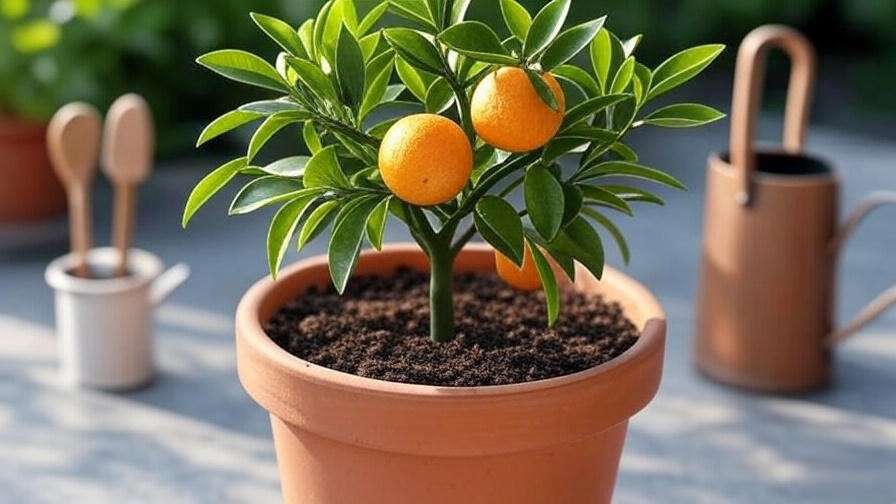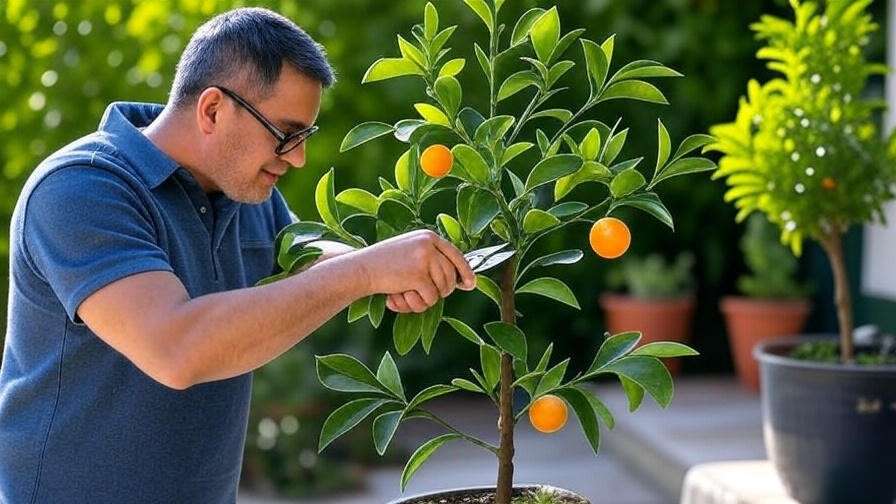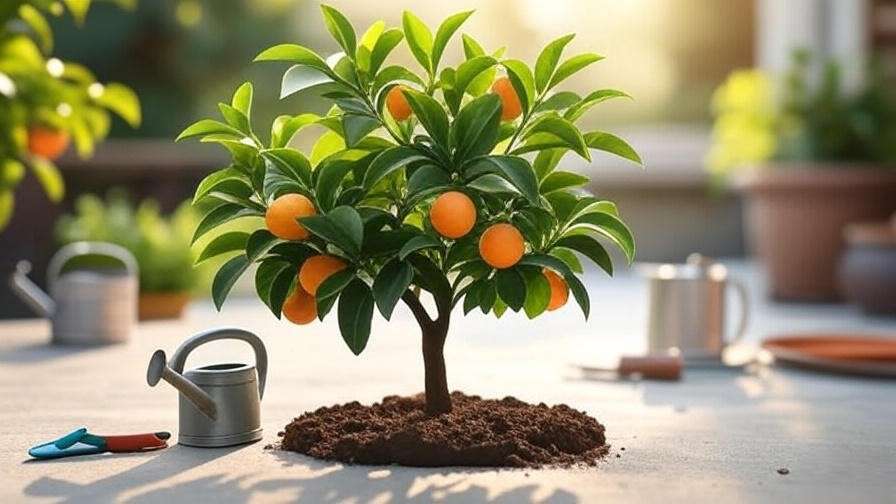Picture this: a vibrant miniature orange tree, its glossy green leaves sparkling in the sunlight, adorned with bright, juicy oranges right on your windowsill or patio! 🍊✨ Growing a miniature orange tree is a delightful way to bring a slice of citrus paradise into your home, even if you’re short on space. Whether you’re a seasoned gardener or a beginner, this compact fruit tree offers both beauty and bounty. In this comprehensive guide, we’ll walk you through every step to cultivate a thriving miniature orange tree, from selecting the perfect variety to harvesting sweet, tangy fruit. Backed by horticultural expertise and trusted resources like the University of Florida’s IFAS Extension, this article delivers practical, actionable advice to ensure your citrus dreams flourish. Expect detailed tips, troubleshooting solutions, and expert insights to make your tree thrive year-round! 🌳
Understanding the Miniature Orange Tree 🌿
What Is a Miniature Orange Tree?
Miniature orange trees, often referred to as dwarf citrus trees, are compact versions of standard orange trees, typically growing between 2 to 6 feet tall. These evergreen beauties are perfect for small spaces, such as apartments, patios, or indoor corners. Varieties like Calamondin, Dwarf Valencia, and Improved Meyer Lemon produce edible, flavorful fruit while maintaining a manageable size. Their glossy foliage and fragrant blossoms make them as decorative as they are functional. According to the University of California’s Agriculture and Natural Resources, these trees are bred for container gardening, making them ideal for urban gardeners or anyone with limited outdoor space.
Benefits of Growing a Miniature Orange Tree
Why choose a miniature orange tree? For starters, their small stature fits perfectly in tight spaces, allowing even apartment dwellers to enjoy homegrown citrus. Their vibrant leaves and colorful fruit add a pop of charm to any setting, doubling as a natural decor piece. With proper care, these trees can produce fruit year-round in warm climates or controlled indoor environments. Plus, tending to a miniature orange tree offers a rewarding, hands-on gardening experience that’s both relaxing and fulfilling. Studies from horticultural societies show that gardening can reduce stress, making this a perfect project for plant lovers seeking joy and productivity.
Ideal Growing Conditions
Miniature orange trees thrive in warm, sunny conditions, mimicking their native subtropical origins. They need 6-8 hours of direct sunlight daily and prefer temperatures between 55-85°F (13-29°C). While they can be grown outdoors in USDA zones 9-11, indoor growing is equally viable with the right setup. Well-draining soil and moderate humidity are key to keeping your tree healthy. Whether you’re placing it on a sunny balcony or near a south-facing window, understanding these conditions sets the foundation for success.
Choosing the Right Miniature Orange Tree 🌳
Selecting a Healthy Tree
When purchasing a miniature orange tree, source it from a reputable nursery or garden center to ensure quality. Look for a tree with sturdy stems, vibrant green leaves, and no signs of yellowing or wilting. Check the roots (if possible) for a healthy, white appearance, avoiding any that are brown or mushy. Avoid trees with visible pests or disease symptoms, such as sticky residue or discolored spots. Experts from the American Horticultural Society recommend choosing disease-resistant varieties to minimize future issues, especially for beginners.
Best Varieties for Beginners
Not sure which variety to pick? Here are three beginner-friendly options:
- Calamondin: Known for its small, tart oranges, this variety is highly adaptable and thrives indoors or out.
- Dwarf Valencia: Produces sweet, juicy oranges ideal for snacking or juicing, with a compact growth habit.
- Improved Meyer Lemon: Technically a citrus hybrid, it offers tangy, orange-like fruit and is forgiving for novice growers.
Each variety has unique flavors and care needs, so choose based on your taste preferences and growing environment.
Planting Your Miniature Orange Tree 🌱
Choosing the Perfect Pot
Container gardening is the go-to method for miniature orange trees. Select a pot that’s 12-16 inches in diameter for young trees, with drainage holes to prevent waterlogging. Terracotta pots are excellent for their breathability, though plastic or ceramic work well if drainage is ensured. As your tree grows, you may need to repot every 2-3 years to accommodate root expansion.

Soil Requirements
Miniature orange trees prefer slightly acidic, well-draining soil with a pH of 6.0-7.0. A mix of potting soil, perlite, and peat moss works wonders. For a DIY blend, combine:
- 50% potting soil
- 30% perlite or sand
- 20% organic compost
This mix ensures proper drainage while retaining enough moisture. Adding a handful of compost during planting provides a nutrient boost for young trees.
Step-by-Step Planting Guide
- Prepare the Pot: Place a layer of pebbles or broken pottery at the bottom to enhance drainage.
- Add Soil: Fill the pot halfway with your soil mix.
- Position the Tree: Gently remove the tree from its nursery pot, loosen the roots, and place it in the center.
- Fill and Firm: Add more soil until the root ball is covered, pressing lightly to secure the tree.
- Water Thoroughly: Soak the soil until water drains out the bottom, ensuring the roots settle.
- Place in Sunlight: Position the pot in a sunny spot to kickstart growth.
Plant in spring or early summer for the best results, as warmer temperatures encourage root establishment.
Essential Care Tips for a Thriving Miniature Orange Tree 🌞
Watering Needs
Watering is a balancing act. Keep the soil consistently moist but not soggy, typically watering every 7-10 days. In hot climates or during summer, you may need to water more frequently. Check the top inch of soil; if it’s dry, it’s time to water. Overwatering can lead to root rot, while underwatering causes leaf drop. A moisture meter is a handy tool for precision, especially for indoor trees.
Sunlight and Temperature
Miniature orange trees crave sunlight—aim for 6-8 hours of direct sun daily. Outdoors, place them in a spot with full sun exposure. Indoors, a south-facing window is ideal, supplemented by grow lights during winter months. Maintain temperatures between 55-85°F, and protect outdoor trees from frost by bringing them indoors or covering them during cold snaps.
Fertilizing for Healthy Growth
Feed your tree with a citrus-specific fertilizer high in nitrogen (e.g., 10-5-5 NPK ratio) every 4-6 weeks during the growing season (spring and summer). Reduce feeding in fall and winter. Avoid over-fertilizing, which can burn roots and cause leaf yellowing. Organic options like fish emulsion are great for eco-conscious gardeners.
Pruning and Shaping
Pruning keeps your tree healthy and productive. In late winter or early spring, use clean, sharp shears to:
- Remove dead or damaged branches.
- Trim overcrowded areas to improve air circulation.
- Shape the tree for a bushy, balanced appearance.
Sanitize tools with rubbing alcohol to prevent disease spread. Regular pruning encourages fruit production and maintains the tree’s compact size.

Common Challenges and Solutions 🐞
Pest Management
Miniature orange trees can attract pests like aphids, spider mites, and scale insects. Inspect leaves regularly for sticky residue or webbing. For organic control, spray with neem oil or insecticidal soap every 7-10 days until pests are gone. Chemical pesticides are a last resort—follow label instructions carefully. Prevent infestations by maintaining good air circulation and avoiding overwatering.
Disease Prevention
Common citrus diseases include root rot (from overwatering) and citrus canker (bacterial). To prevent issues:
- Ensure proper drainage and avoid waterlogged soil.
- Remove affected leaves promptly and dispose of them securely.
- Follow USDA guidelines for early detection, such as monitoring for lesions or unusual spots.
Troubleshooting Yellowing Leaves
Yellow leaves can signal multiple issues:
- Nutrient Deficiency: Apply a citrus fertilizer to correct nitrogen or magnesium shortages.
- Overwatering: Check soil drainage and reduce watering frequency.
- Insufficient Light: Move the tree to a sunnier spot or add grow lights.
Diagnose by process of elimination, starting with the most common cause (watering issues).
Encouraging Fruit Production 🍊
Pollination Tips
Miniature orange trees often need a helping hand to produce fruit, especially when grown indoors. For indoor trees, hand-pollination is simple and effective. Using a small paintbrush or cotton swab, gently transfer pollen from the stamen (the pollen-covered part) of one flower to the pistil (the central part) of another. Repeat this process across multiple flowers to maximize fruit set. Outdoors, attract pollinators like bees by placing your tree near flowering plants or using companion plants like lavender. According to the University of Florida’s IFAS Extension, consistent pollination can significantly boost fruit yield, even in compact citrus varieties.
Maximizing Fruit Yield
To ensure a bountiful harvest, maintain a consistent care routine. Regular watering, proper fertilization, and adequate sunlight are critical for fruit development. Stress factors like irregular watering or nutrient deficiencies can cause flowers or young fruit to drop prematurely. Monitor your tree for signs of stress, such as wilting leaves or sparse flowering, and address them promptly. Pruning also plays a role—removing excess branches allows the tree to focus energy on fruit production. For optimal results, ensure your tree gets at least 6 hours of sunlight daily and fertilize monthly during the growing season with a citrus-specific blend.
When and How to Harvest
Miniature oranges are ready to pick when they turn a deep, vibrant orange and feel slightly soft to the touch. Taste-test one fruit to confirm ripeness, as color alone isn’t always reliable. To harvest, gently twist the fruit or use clean pruning shears to snip it from the stem, avoiding damage to the branch. Harvested oranges can be stored at room temperature for up to a week or in the refrigerator for up to a month. Regular harvesting encourages the tree to produce more fruit, so don’t let ripe oranges linger too long!

Indoor vs. Outdoor Growing: Key Considerations 🏡🌳
Indoor Growing Tips
Growing a miniature orange tree indoors is perfect for urban gardeners or those in colder climates. Place your tree near a south-facing window to maximize sunlight exposure. If natural light is limited, invest in a full-spectrum grow light to provide 12-16 hours of light daily. Maintain humidity levels around 50-60% using a humidifier or by placing a tray of water with pebbles near the tree. Good air circulation is also key—use a small fan to prevent mold and pests. During winter, keep the tree away from drafty windows or heating vents to avoid temperature fluctuations.

Outdoor Growing Tips
Outdoor miniature orange trees thrive in warm, sunny climates (USDA zones 9-11). Place your tree in a spot with full sun and protection from strong winds. If you live in a region with occasional frost, be prepared to cover your tree with frost cloth or bring it indoors during cold snaps. For patio growing, use a heavy pot to prevent tipping and ensure the soil stays well-drained. Mulching around the base with organic material like bark chips helps retain moisture and regulate soil temperature. Regularly check for pests, as outdoor trees are more exposed to insects.

Seasonal Care Calendar 📅
To keep your miniature orange tree thriving year-round, follow this seasonal care guide:
- Spring: Fertilize monthly, prune for shape, and check for pests. Start hand-pollination if flowering begins. Repot if the tree is root-bound (every 2-3 years).
- Summer: Increase watering frequency, ensure 6-8 hours of sunlight, and monitor for fruit set. Apply neem oil if pests appear.
- Fall: Reduce fertilization and watering as growth slows. Prepare outdoor trees for cooler weather by mulching or moving indoors.
- Winter: Protect from frost, reduce watering, and use grow lights for indoor trees. Inspect for indoor pests like spider mites.
Downloadable Resource Idea: Create a printable seasonal care calendar for readers to track tasks, available via a link on your website.
Expert Tips for Long-Term Success 🌟
For a flourishing miniature orange tree, consider these expert-backed tips:
- Rotate Indoor Trees: Turn your pot every few weeks to ensure even sunlight exposure, preventing lopsided growth.
- Use Citrus-Specific Products: Invest in citrus-specific fertilizers and pest sprays for tailored care, as recommended by the American Horticultural Society.
- Get Creative with Fruit: Use miniature oranges in recipes like marmalade, salads, or cocktails, or dry the peels for aromatic decor.
- Propagation Fun: Experiment with growing new trees from cuttings or seeds. Soak seeds in water for 24 hours before planting in a seed-starting mix for best results.
Horticulturists emphasize patience—miniature orange trees may take 1-3 years to bear fruit, but consistent care yields rewarding results.
FAQs About Miniature Orange Tree Care ❓
Q1: How long does it take for a miniature orange tree to bear fruit?
A: Most miniature orange trees start producing fruit within 1-3 years, depending on the variety, care, and growing conditions. Calamondin trees often fruit faster than Dwarf Valencia.
Q2: Can I grow a miniature orange tree indoors year-round?
A: Yes! With 6-8 hours of sunlight (or grow lights), proper humidity, and consistent care, miniature orange trees thrive indoors year-round.
Q3: Why is my tree dropping fruit prematurely?
A: Fruit drop can result from stress, such as irregular watering, insufficient light, or nutrient deficiencies. Ensure consistent care and check for pests.
Q4: How often should I repot my miniature orange tree?
A: Repot every 2-3 years or when roots become crowded. Choose a pot 2-4 inches larger in diameter to allow growth.
Q5: Are miniature oranges safe to eat?
A: Yes, most miniature orange varieties produce edible fruit, though flavors vary (e.g., Calamondin is tart, while Dwarf Valencia is sweet). Always confirm the variety is edible before consuming.
Conclusion
Growing a miniature orange tree is a rewarding journey that brings beauty, fragrance, and delicious fruit to your home or garden. 🌱🍊 By following this guide—covering everything from planting and care to troubleshooting and harvesting—you’re equipped to cultivate a thriving tree that produces vibrant oranges year after year. Start with a healthy tree, provide consistent care, and don’t hesitate to experiment with pollination or creative uses for your harvest. Ready to get started? Plant your miniature orange tree today and share your progress in the comments below! For more citrus care tips, explore our related articles on growing lemon trees or creating a thriving indoor garden. 🌳✨













